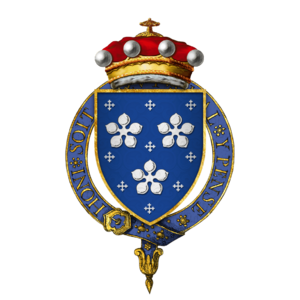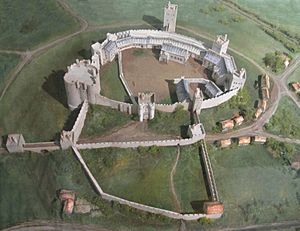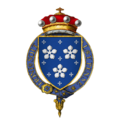Thomas Darcy, 1st Baron Darcy de Darcy facts for kids
Quick facts for kids
Thomas Darcy
|
|
|---|---|
| Baron Darcy of Darcy | |

Arms of Lord Darcy
|
|
| Born | c. 1467 |
| Died | 30 June 1537 (aged 69–70) Tower Hill, London |
| Buried | St Botolph's Aldgate, London 51°30′50″N 0°04′34″W / 51.513889°N 0.076111°W |
| Noble family | Darcy |
| Spouse(s) | Dousabella Tempest Edith Sandys |
| Issue | George Darcy, 1st Baron Darcy of Aston Richard Darcy Sir Arthur Darcy Mabel Darcy Elizabeth Darcy |
| Father | Sir William Darcy |
| Mother | Euphemia Langton |
Thomas Darcy, 1st Baron Darcy of Darcy (around 1467 – 30 June 1537) was an important English nobleman. He was the only son of Sir William Darcy and Euphemia Langton. Lord Darcy was against the Dissolution of the Monasteries, which was when King Henry VIII closed down monasteries.
He played a part in a major uprising called the Pilgrimage of Grace. Because he handed over Pontefract Castle to the rebels, he was accused of serious disloyalty to the king. He was put to death on Tower Hill on 30 June 1537.
Contents
The Darcy Family History
The Darcy family had owned land in Lincolnshire for a very long time. Records from the Domesday survey show that a Norman de Areci received many lands from William the Conqueror. Over time, the family name changed from d'Arci to d'Arcy and then to Darcy.
During the reign of King Edward III, the family gained more lands through marriage. One of these was their family home, Templehurst (or Temple Hurst), near Selby in Yorkshire. Thomas Darcy's father, Sir William Darcy, passed away in 1488, leaving Thomas as his only son and heir.
Family Life and Children
Thomas Darcy married twice. His first wife was Dousabella Tempest, who passed away before 1500. She was the daughter of Sir Richard Tempest.
Together, Thomas and Dousabella had four children:
- George Darcy, who later became the 1st Baron Darcy of Aston. He was knighted in 1513.
- Richard Darcy
- Sir Arthur Darcy, who was knighted in 1523.
- Mabel Darcy
Later, around 1500, Thomas Darcy married Edith Sandys. She was the daughter of Sir William Sandys and had been married before.
Thomas and Edith had one daughter:
- Elizabeth Darcy, who married Sir Marmaduke Constable in 1514.
Through his marriage to Edith, Thomas Darcy also became the stepfather to Ralph Neville, who later became the 4th Earl of Westmorland. Edith passed away in 1529 in Stepney, London.
Lord Darcy's Career and Public Service
Thomas Darcy was known for his military skills early in his life. He showed great ability during the reign of King Henry VII.
Important Roles and Honours
Over the years, Lord Darcy held many important positions and received several honours:
- He became a Knight in 1489.
- He was made a Knight Banneret in 1497.
- He became the Constable of Bamburgh Castle in 1498.
- From 1498 to 1515, he was the Captain of Berwick.
- In 1501, he became the Treasurer of Berwick.
- He was appointed Warden of the East Marches in 1505.
- In 1509, he became a Knight of the Garter, a very high honour.
- He was also made Warden of the Royal Forests north of Trent in 1509.
- In 1509, he was given the title of Baron Darcy (of Darcy or of Temple Hurst).
- He became Warden of both the East and Middle Marches in 1511.
- In 1513, he joined the Privy Council, advising the King.
Early Political Steps
In 1492, Thomas Darcy agreed to serve King Henry VII overseas with a thousand men. Later that year, he met with French ambassadors who came to discuss peace. In 1497, he helped lead troops to defend Norham Castle against the Scottish King James IV.
He was a knight who served the King directly. In 1498, he became the constable of Bamburgh Castle in Northumberland. He was also appointed deputy warden of the Scottish borders, working under Henry, Duke of York, who was only seven years old at the time. While on the borders, he often wrote to Bishop Fox, a key minister to King Henry VII.
In 1498, he helped assess fines for people who had supported Perkin Warbeck's rebellion in Devon and Cornwall. He also helped settle disputes with Scotland as an ambassador in 1499. In 1501, he became treasurer and chamberlain of Berwick. In 1502, he traveled to Scotland to receive King James IV's oath for a peace treaty.
He was appointed constable of Sheriff Hutton around 1500. In 1505, he was first called Lord Darcy. He became warden of the east marches, a very important role in northern England.
In 1508, he was one of the lords who agreed to the marriage treaty between the King's daughter, Mary, and Charles of Castile. After Henry VIII became King, Darcy was made a Knight of the Garter in 1509. He also became a member of the King's council and was summoned to Parliament as Baron Darcy de Darcy.
Trips Abroad
In 1511, Lord Darcy went to Spain to help King Ferdinand fight against the Moors. He was given a special role as Ferdinand's admiral. However, soon after the English troops arrived, problems arose, and Ferdinand decided he didn't need their help. Darcy was very disappointed and returned home.
After his return, he was appointed warden of both the east and middle marches against Scotland, but he resigned this role later that year. In 1512 and 1513, he sent important updates to the King and Wolsey about events in Scotland. In 1513, he joined the King in invading France and was at the siege of Thérouanne.
More Public Service
In 1514, his son, Sir George Darcy, began to share some of his appointments. In 1515, Lord Darcy stepped down as captain of Berwick. He attended Parliament and was present in London when Wolsey received his cardinal's hat.
In 1517, he welcomed Margaret, the widow of James IV, when she returned to Yorkshire on her way back to Scotland. In 1518, he was among those who met Cardinal Campeggio on his first visit to England. In 1519, he helped with a search for suspicious people in London.
In 1520, he gave up his offices in Sheriff Hutton to his friend, Sir Robert Constable. He was also listed to accompany the King to the Field of the Cloth of Gold, a famous meeting between Henry VIII and the French King.
In 1523, he actively participated in the war against Scotland, leading raids on the borders with 1,750 men. His annual income from his lands was quite large, and he paid a significant amount in taxes.
Wolsey's Decline
In 1529, Lord Darcy helped bring about the downfall of his old friend Wolsey. He wrote a long list of accusations against Wolsey, saying he did it out of duty to God and the King. That same year, he was questioned about Prince Arthur's marriage to Catherine of Aragon, though he had little information as he was serving in the north at the time.
He was one of the noblemen who signed the accusations against Wolsey in Parliament. The following year, he signed a letter from English lords to Pope Clement VII. This letter warned the Pope about the dangers of not granting King Henry VIII's request for a divorce.
Disagreeing with the King
However, Lord Darcy soon became a strong opponent of the King's court regarding the divorce. In 1532, the Duke of Norfolk spoke in Parliament, saying the King was treated unfairly by the Pope. He asked if they would support the King's power against outside interference. Lord Darcy was the first to reply. He said his loyalty was to the King, but he believed marriage matters were spiritual and belonged to the Church.
After this, it's not surprising that he was told his presence would not be needed at the January 1534 Parliament session, even though he had been officially summoned.
In July 1534, he was part of the jury that found Lord Dacre innocent. This action did not make him more popular with the King's court. However, Thomas Cromwell, a powerful minister, seemed to be his friend at this time. Cromwell helped Darcy's second son, Sir Arthur Darcy, become governor of Jersey.
Lord Darcy wrote to Cromwell thanking him, explaining he couldn't visit in person due to his "fulsum diseassis" (a rupture). He also sent messages to Cromwell and the Duke of Norfolk, complaining that he hadn't been allowed to return home to Yorkshire since Parliament began in 1529.
The Rebellion and Its Aftermath
In the same month his son became governor of Jersey, Lord Darcy began secretly talking with Eustace Chapuys, the ambassador from the Holy Roman Empire. Along with Lord Hussey, he tried to persuade the Emperor to invade England. He claimed the nation was suffering under the King's rule and needed a deliverer.
His strong desire to go home to Yorkshire was so he could help the invaders when the plan started. He even managed to get permission to miss future St. George's Day feasts and Parliament meetings due to his age and weakness.
He thanked Cromwell for these privileges in November, writing from Templehurst. However, he was likely still in London, as he wasn't allowed to return home for some time. The King's court probably suspected his presence in the north would cause trouble. He stayed in London until at least July 1535. He appears to have been at Templehurst in April 1536.
Because he wasn't required to attend the Parliament session in February 1536, he avoided pressure to vote for the dissolution of the smaller monasteries. This measure was very unpopular in northern England and was a main cause of the Pilgrimage of Grace, a large rebellion that began in October 1536.
Pontefract Castle, which Darcy commanded, was one of the few places that resisted the rebels for a while. Archbishop Lee of York and some local gentry fled there for protection. However, Darcy claimed he was running out of supplies and surrendered the castle to the rebels. They forced him and the archbishop to join their cause.
Darcy, the archbishop, and most of the gentry actually agreed with the rebels. Darcy later argued that he was trying his best to help the King by guiding a force he couldn't stop. He stood with Robert Aske, the leader of the common people, and negotiated with the Dukes of Norfolk and Suffolk, who were sent to stop the uprising.
The King himself recognized Darcy as a leader of the rebels. He instructed Norfolk to offer Darcy and others a free pardon if they surrendered. Norfolk even suggested Darcy could redeem himself by betraying Aske. Darcy, who valued his word, angrily refused. Both he and Aske wrote to the King to explain their actions.
A meeting with the King's council was arranged at Doncaster, and the King offered a pardon. However, in January 1537, Henry ordered Darcy to come to London. Darcy wrote back from Templehurst, saying he had served the King faithfully for about fifty years. He explained that he was confined to his room with two illnesses since the Doncaster meeting.
At that time, a new rebellion had just started. Aske and Darcy worked hard to stop it. Their efforts were so helpful that the King pardoned both of them. Darcy was encouraged to resupply Pontefract Castle so his sons, Sir George and Sir Arthur, could hold it if another uprising happened. Darcy was assured that if he did his duty, his past actions would be forgiven.
Encouraged, he wrote to Aske on February 10, asking him to secretly return bows and arrows to Pontefract Castle. This letter was unfortunately intercepted. It suggested that Darcy was still involved in promoting change. Even his recent actions for the King were used against him.
Arrest and Final Days
Lord Darcy was arrested, brought to London, and held in the Tower of London, along with other northern leaders.
When questioned by the Privy Council, Darcy openly expressed his strong dislike for Thomas Cromwell. He called Cromwell the main cause of the rebellion and accused him of trying to bring noblemen to their end. He warned Cromwell that the King's favour might not last, saying that others who had been in such favour with kings had met the same fate. He hoped that even if Cromwell removed every nobleman, the King would eventually remove Cromwell.
An accusation against Darcy and other northern leaders in May stated they had conspired to remove the King's title as Supreme Head of the Church of England and force him to hold a parliament. It also said they committed rebellious acts and, after being pardoned, supported the new rebellion in January.
On May 15, Darcy and his friend, John Hussey, 1st Baron Hussey of Sleaford, were put on trial in Westminster. They were found guilty and sentenced to the extreme punishment for disloyalty. However, they were both put to death by beheading. Lord Hussey was beheaded in Lincoln, while Darcy was beheaded on Tower Hill on June 30. His head was placed on London Bridge. His body was likely buried at St Botolph's Aldgate.
After his arrest and conviction in 1537, his lands and property were taken by the King. In 1539, his title was officially taken away. During the reign of King Edward VI, his eldest son, Sir George Darcy, had his rights restored by an Act of Parliament in 1548 and was given the title of Baron Darcy. This was seen as a new creation of the title. The title of Lord Darcy of Aston continued through his male heirs until it ended in 1635.
Images for kids






